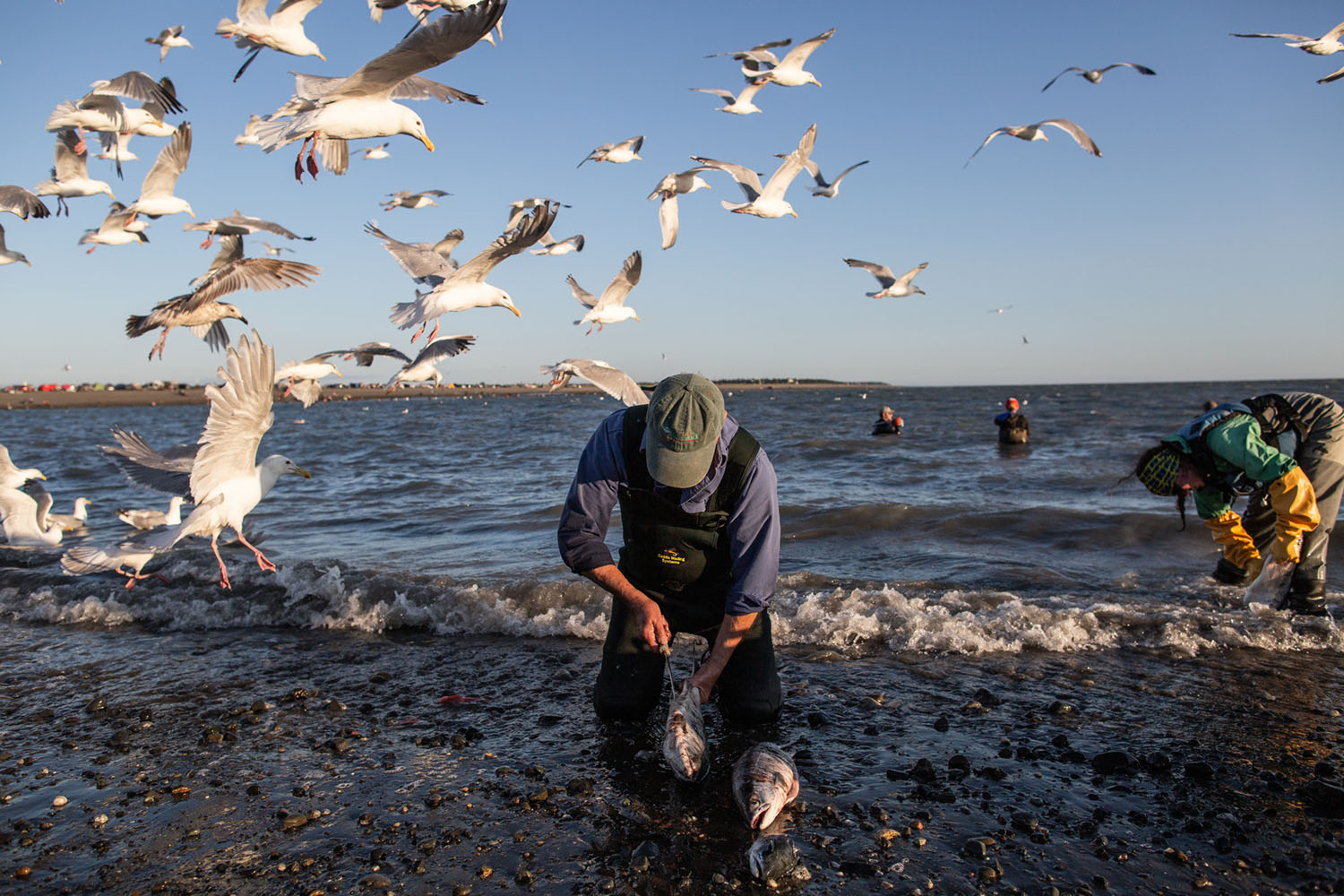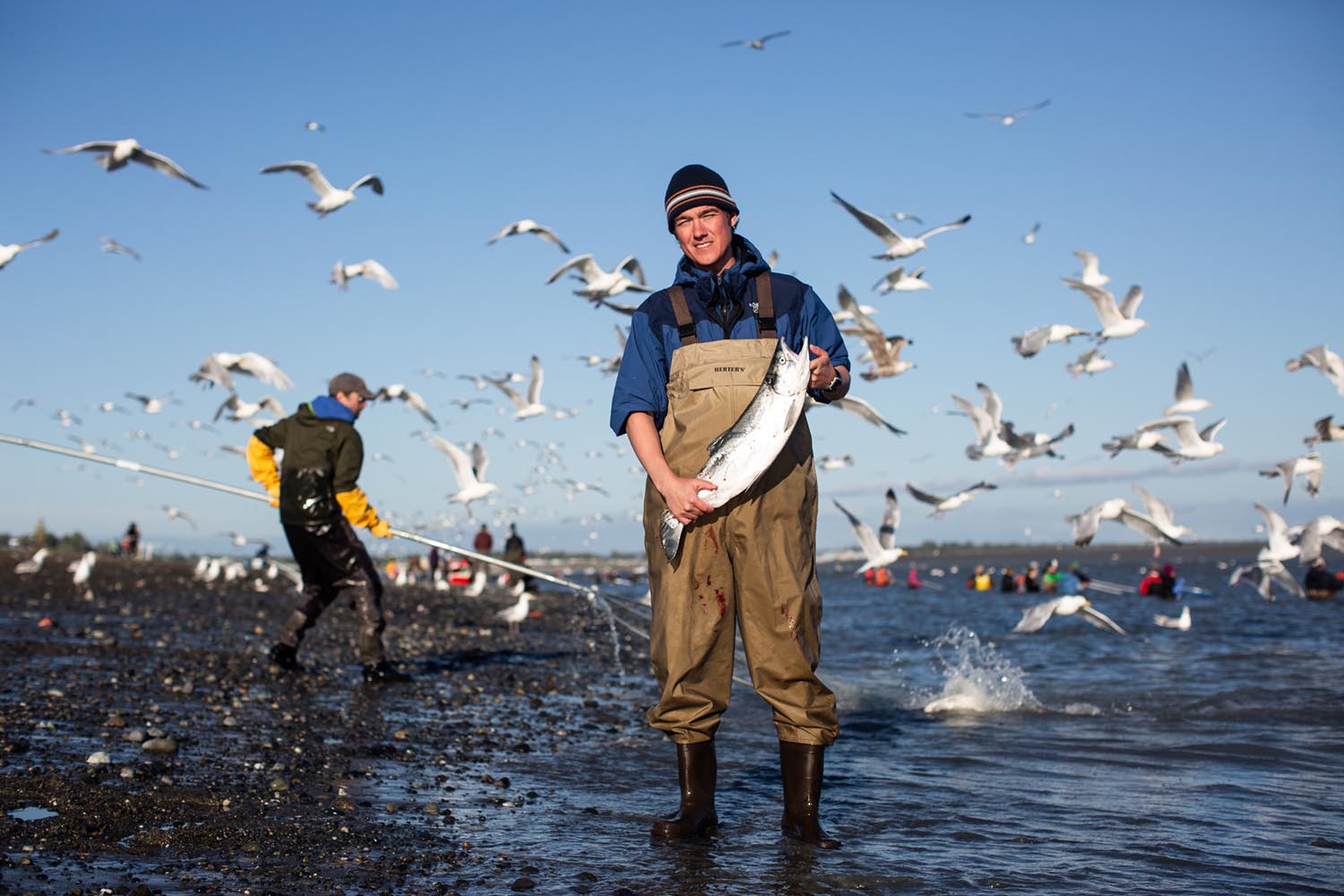This story was produced by the Food & Environment Reporting Network, a non-profit news organization.
Cortney Edwards’ camp at the mouth of the Kasilof River in south central Alaska looks like a preschool in the sand. His white Suburban and a long piece of driftwood cordon off a stretch of beach that is filled with toys, a pink princess tent, camp chairs sized for the kindergarten set, and an outdoor kitchen under a portable canopy. Here with his wife, two adult daughters, five grandchildren, and two foster kids, the 59-year-old—who works as a safety and security specialist at a public high school in Anchorage—is camping with a singular goal: to catch a year’s worth of salmon. Scores of other Alaskans, in their own jumble of trucks, tents, and ATVs, are here for the same exact reason.
As salmon make their epic voyages from the sea to upriver spawning grounds, Alaskans crowd shorelines to catch enough fish to put up for the winter. In the process, they tie themselves to trees so they can fish over steep riverbanks, filet salmon on ironing boards and the lids of coolers dragged across the sand, scale waterfalls to fish in frothy pools, and net fish while floating downstream in dry suits. Edwards and the others in this temporary encampment are here to dipnet, which involves standing in the river in chest waders and muscling a long-handled net into the current to intercept fish heading upstream.
While subsistence fishing and hunting traditions are woven into Alaska’s Native cultures, and are a primary way rural villagers stock their pantries, Alaskan urbanites likewise descend on salmon runs each summer in a harvest frenzy. This year, for many Alaskans, catching a lot of fish has taken on new urgency because of the COVID-19 pandemic. In March, as panic shoppers stripped store shelves bare, Edwards couldn’t find the food he and his family needed at Walmart, where he usually shops for groceries. “It was quite scary,” he says.
Edwards drove three hours from Anchorage to reach the Kasilof—others came from as far as Fairbanks, 500 miles away—but he hopes to return home with dozens of bright, fresh salmon, which he’ll process into well over 100 pounds of filets.
Restricted to state residents, these “personal use fisheries,” as they’re known in Alaska, are regulated fishing opportunities managed by state fish and game officials, who dictate when and where people can fish, what gear they can use, and how much they can harvest. All you need is a $29 fishing license—$5 for residents whose income meets federal poverty guidelines—and, in most cases, a free permit. On the Kasilof, the harvest limit is 25 fish for the head of the household, plus an additional 10 salmon for every other family member, whether they’re also on the fishing grounds or not. State law mandates that salmon caught in these fisheries are for home use; they cannot be sold or bartered. Participants are required to mark their salmon by snipping off tail fins so the fish can’t enter commercial markets. Alaskans freeze, can, smoke, pickle, and salt fish to preserve it for the months ahead.

Nathanial Wilder
These fishing opportunities are enormously popular. Last year, more than 24,000 people participated, harvesting hundreds of thousands of salmon over the summer. Some years, the state restricts commercial and sport fishing because of low salmon returns. But if state authorities considered shutting down a personal use fishery at the peak of the run, Dave Rutz, the director of the sportfish division at the Alaska Department of Fish and Game, explains, “I’d be up to my neck in phone calls.”
A festive sense of lawlessness prevails along the Kasilof. No rules dictate how or where you can camp. There is no electricity or drinking water source, and the nearest toilet is a porta-potty more than a quarter mile down the beach. Pickups and four-wheelers whiz through the deep sand, smoke wafts from campfires, and tunes blast sporadically from truck stereos. Also: no one is wearing a mask.
Most Alaskans would agree that the open setting provides plenty of fresh air and sunshine, and family groups, for the most part, distance themselves from others. Alaska was one of the first states to reopen following a strict shutdown. Although its total number of confirmed COVID-19 cases has remained low—about 3,100 since testing began—the virus has been exploding since restrictions were lifted in late May, and Alaska is currently seeing one of the highest transmission rates in the country. Anchorage—the state’s largest city—just reversed course and reinstated a partial shutdown.
While Alaska has suffered far fewer deaths and hospitalizations than most of the rest of the nation, the pandemic has rocked the state’s economy, which is heavily dependent on tourism and petroleum, two sectors bludgeoned by shutdowns. COVID-19 has also stressed the state’s food system, a thousand-mile-long supply chain that delivers nearly all Alaska’s groceries.
The empty shelves that Edwards confronted in the spring have sent Alaskans to riverbanks with added fervor this summer. John Morton is one of them. The retired wildlife biologist who, like Edwards, dipnets on the Kasilof, says that he had never thought much about food security before now. But he anticipates the pandemic will get worse. “Nationwide, we’re setting up for a total shutdown,” he says. Morton aims to catch 40 or 50 salmon this season, doubling his typical harvest. “I think having a lot of stuff in your freezer or canned on your shelves is a good thing.”
Amanda Campbell and her family, including two boys, ages three and six, harvest salmon each summer with a setnet. Anchored to the beach near the mouth of the Kasilof, the net entangles salmon when the tide comes in. “We have felt more of an urgency this year with making sure we have fish for the winter,” she explains. Campbell and her family, who live in Homer, a little more than an hour away, have also expanded their garden and are planning to build a root cellar and raise chickens for eggs.
Less than a dozen miles away from the Kasilof, the fish—and the crowds—are even bigger on the Kenai River. Charlie Trowbridge has dipnetted there for the last 20 years. He also hunts for moose and caribou, but those forays require longer travel and the ability to lug meat out of the backcountry. And hunting isn’t always successful. “I don’t know an easier way to get that protein,” he says of the Kenai fishery.
“You gotta have fish in your freezer and toilet paper in your cupboard,” says Dennis Ramirez, who, like Edwards, drove to the Kasilof from Anchorage and was using a setnet to fill his freezer. Before COVID-19 hit, he’d grocery shop once a week. Now he tries to limit those trips to once every three weeks.
Personal use fisheries—and a pantry full of salmon—could be a good way for Alaskans to ward off food insecurity, which, like other impacts of the pandemic, has hit the state’s low-income families the hardest. Demand at Alaska food banks is up 75 percent over this time last year. Yet, despite the fact that hundreds of thousands of salmon are available for harvest through personal use fisheries around the state, the families most in need may be unable to access these opportunities. “There’s an educational element and there’s an equipment element” to personal use fishing, says Cara Durr, of the Food Bank of Alaska. Participating in these fisheries may require a boat, the flexibility to time fishing with tides that might be in the middle of the night or very early morning, and a commitment of many hours—if not days. And then there’s the cost of gas, nets, and, in some cases, camping or parking fees.
The state doesn’t track the income of those who participate in personal use fisheries, but records show that even as the number of poor Alaskans is rising, the number of discounted, $5 fishing licenses has dropped by one quarter in recent years.

Nathanial Wilder
These fishing frenzies have other drawbacks. With harvest limits set so high—up to 20 servings of salmon per week for a family of four—fish and game officials annually receive reports of waste, and it’s not uncommon to see freezer-burned salmon from huge summer harvests offered up as dog food the following spring. In addition, the crowds gathered along rivers are notorious for leaving dumpsters overflowing with trash as well as human waste. Clumps of toilet paper dot the edge of the beach.
Personal use fishing can be dangerous, too. Earlier this summer, a 23-year-old man died when the 14-foot skiff he was riding in overturned at the entrance to a popular dipnetting spot at the mouth of south-central Alaska’s China Poot Bay. And last year, a 35-year-old drowned when he was swept into the Copper River while dipnetting salmon.
And yet Alaskans continue to swarm these runs, perhaps mindful that the bounty may not last forever. Since the middle of the 20th century, climate change has warmed Alaska at twice the rate of the global average. Last summer, numerous rivers in Alaska ran too hot for salmon. They washed up on banks by the tens of thousands—likely victims of heart attacks caused by heat—even while overall harvest numbers, in most cases, remained strong.
Increasingly, Alaska’s salmon are facing the kinds of pressures that have decimated their runs globally, including growing competition from the more than 5 billion hatchery fish released annually into the North Pacific and the expansion of urban development along Alaska’s waterways. Moreover, the controversial Pebble Mine, an open-pit copper and gold mine proposed for the headwaters of Bristol Bay, the largest sockeye fishery in the world, is being fast-tracked by the Trump Administration. The project took a huge step closer to development last week with the release of a key Army Corps of Engineers report.
Taking a break from the river’s swift current, while the gulls whine overhead, Edwards isn’t worried about diminished salmon returns. But with the Anchorage School District reversing an earlier decision to open classrooms next month, he is concerned about the future of his job. Still, fear of being laid off or facing empty grocery stores isn’t what brought him and his family to the sandy edge of the river this summer. It is the love of fishing. Edwards remembers his first time netting a salmon while standing in the silty waters of Fish Creek, near Anchorage, not long after moving to the state from Houston in the 1980s.
“You’re doing something that you never even thought of before,” he says. He couldn’t see the fish in the water, but when he felt that sudden tug on his net, “it was the most exhilarating thing.”
For Edwards and other Alaskans, hauling in salmon in these fisheries has always been a great deal of fun. This year, it may also be a matter of survival.
